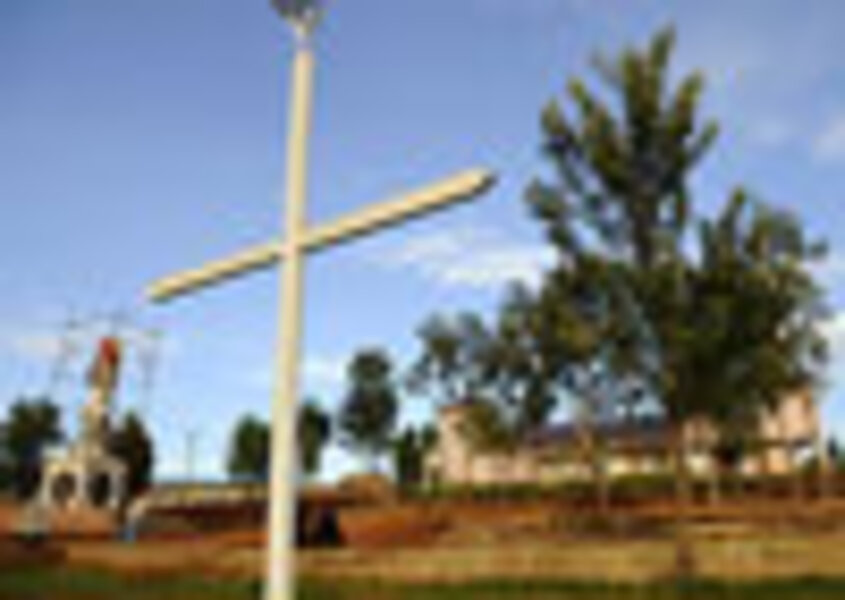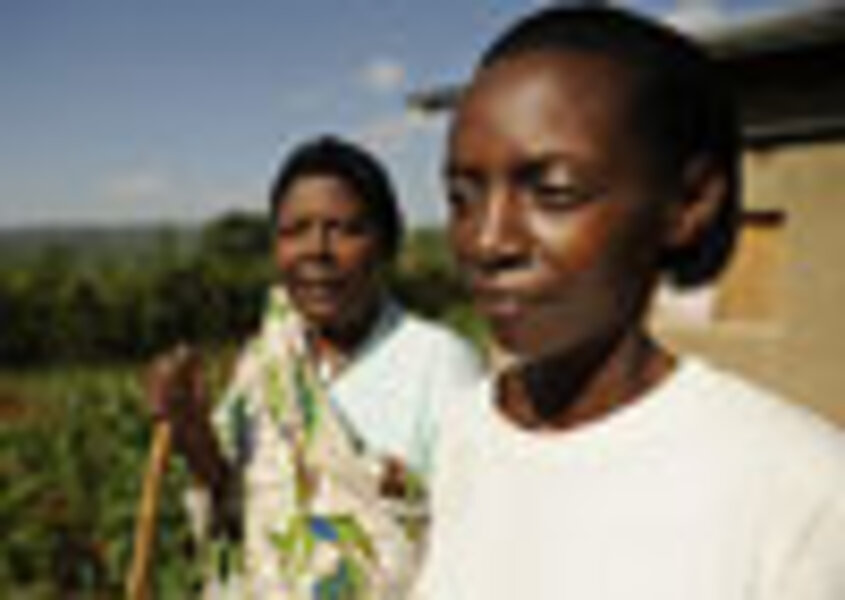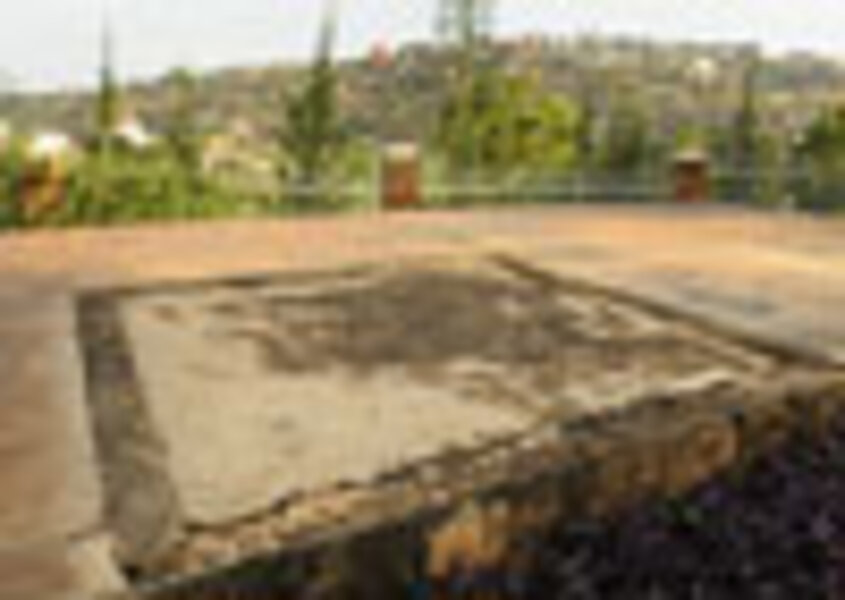Rwandans: a reeducation in how to live together
| Kigali, Rwanda
Two years ago today, Christine Uwimana buried her family. She pulled their bones from one mass grave and brought them to another.
She remembered where the killers had left her family, because they had left her there, too. They shot her in the right shoulder and tossed her into a hole that felt 100 feet deep. She doesn't remember how she crawled out, or how she eluded the men with machetes still hunting her neighbors and friends. She doesn't remember anything, really, about how she survived the 1994 Rwandan genocide, when Hutu militiamen killed 800,000 of their Tutsi countrymen, but she remembers where she almost died.
"Because I was thrown in the hole," she says, "I was able to know where my family members were. Now, they are at Gisozi."
This is a mourner's shorthand. Gisozi is the neighborhood that houses the Kigali Genocide Memorial Center – a museum, frequented most often by foreigners, and a collection of mass graves, where survivors rebury their loved ones. To be at "Gisozi" is to be buried with intention – to share a coffin with other family members and to be laid to rest with ritual. To know where your family is buried, survivors say, is to know at least some peace.
That's no small thing here, where Rwandans this week are marking the 15th anniversary of the genocide. Since then, the country has seen political stability, thanks to the strict rule of Rwandan President Paul Kagame – and in spite of a lingering threat from thousands of armed Rwandan Hutus, many of whom have lived just over the border, in neighboring Democratic Republic of Congo, since the genocide ended.
But peace between Hutu and Tutsi neighbors within Rwanda has been an altogether different challenge. Tiny and poor, Rwanda is Africa's most densely populated country. Divided by history and trapped by poverty, Rwandans have no choice but to learn how to live with the legacy of genocide – and with each other.
It's a task that has, for the past several years, played out publicly – at local courts designed to try genocide crimes and at "re-education camps," where thousands of Rwandans spend two months learning the history and culture of a "new" Rwanda.
But how well have these efforts worked?
"It's a mixed picture," says Timothy Longman, African politics professor at Vassar College in Poughkeepsie, N.Y., of the Rwandan government's success at reuniting the country. "On the one hand, they are very sincerely interested in ... promoting national unity ... and avoiding future violence.... But on the other hand, the government very, very tightly constrains public space, so that it's difficult for people ... to talk about ongoing ethnic discrimination."
The country officially banned the ethnic labels "Hutu" and "Tutsi" five years ago, but observers say the legacy of genocide isn't as easily overcome, and suspicions between groups linger. Confessed genocidaires have returned from prison, and former members of a Hutu militia have come home after fighting in Congo. Amid these returnees, Tutsi survivors have come forward to testify before local courts, called gacaca, about who killed whom. Considered a civic duty, testifying can be risky: In recent years, 17 survivors were killed, including one gacaca judge, in what survivors fear are acts of reprisal for bearing witness. Still, most find ways to accept, if not welcome, returning Hutus.
"I give a lot of credit to survivors that, rather than seek vengeance, are finding ways to come together with their former neighbors," says Mr. Longman, who has been working in Rwanda for more than 20 years. "Survivors really are the group taking the lead in reconciliation."
The search for justice
"When you give testimony, and he gets out, at some point you are scared," Ms. Uwimana says. She and her 80-year-old mother live alone in a small house near Rwanda's capital, Kigali; Uwimana's husband died just before the genocide, and her son goes to school about an hour-and- a-half away. If she were to face any danger, she would face it alone.
"Me, I'm not scared," she insists. "I trust God to protect me. I didn't lie about what he did. And he accepted it."
"He" is the man who shot her. He was with the militias who came to her home, forced her and 10 family members outside, shot them, and threw them into a makeshift mass grave. Uwimana, and her mother and sister, managed to survive and crawl out of the grave, but she doesn't remember anything else about her survival.
Last fall, at gacaca, Uwimana recounted the story before the nine inyangamugayo, or "persons of integrity," who oversee the trials. Gacaca courts adapt a traditional dispute-resolution mechanism that Rwandans used before the country was colonized by Belgium.
Before, the inyangamugayo were respected village elders; these days, they're elected by the community, their backgrounds vigorously investigated. Roughly 40,000 elected judges were dismissed for crimes as minor as small property infractions and for any hint of connection to genocide.
After several years of pilot trials, gacaca started nationwide in 2006, with over 12,000 courts meeting every week until just last month. The elected inyangamugayo effectively served as both judges and jury, listening to witnesses and rendering a sentence. They were also de facto lawyers, rigorously questioning everyone who testifies before opening the floor to the community to do the same.
The process has not been without its critics. Human rights groups have objected to the lack of legal representation for the accused, who are tried in abstentia if they repeatedly fail to fulfill their summons. Some experts even raise concern about the scope of gacaca jursdiction, which does not include crimes alleged to have been committed by the Rwandan Patriot Front, the former rebel forces led by President Kagame and credited with ending the genocide.
"Gacaca has focused on even the most minute property crimes that were committed by Hutu against Tutsi," says Longman. "The problem is that there has been very little justice on the flip side of that; that is, there's been almost no accountability for RPF crimes against Hutu."
But Stephen Kinzer, author of the Kagame biography "A Thousand Hills," says gacaca has been necessarily limited from the outset by its dual purposes.
"Gacaca tries to combine the two necessities [Rwandans] see in the reconciliation process. One is justice, that is, the punishment of the guilty, and the other is reconciliation. In many ways, the two are contradictory. The gacaca system, although highly imperfect, is a way to try to balance those two," Mr. Kinzer says.
Gacaca testimonies can be hard to hear
Gacaca has gotten mixed marks inside Rwanda, as well. Some survivors question the need to dredge up the past; others say the national healing process requires the information they produce. Even some who support the courts have difficulty participating.
"My sister refused to go to gacaca," Uwimana says. "Every time she was thinking about her two boys [who died in the genocide], she would fall apart. She was too fragile to go there."
Government officials had anticipated that kind of reaction. In 2003, the National Unity and Reconciliation Commission surveyed Rwandans to measure expectations, a full year before pilots began. Over 50 percent of survivors expected giving or listening to testimony to retraumatize them.
"During gacaca activities, people heard what they did not expect," says Denis Bikesha, director of training, sensitization and mobilization services at the National Service of Gacaca Courts. "You may know that members of your family have died, but you may not know the ways."
Uwimana says this is the kind of information that has kept her away from gacaca.
"It's harder to hear from the killers ... than to listen to the survivors," she says. "When you hear about how they did it—how they cut hands, how they hacked people—that's harder than victim testimony."
But knowing where her family had been left, she says, brought her as close as she expects to get to closure. Survivors express skepticism about forgiveness for or reconciliation with genocidaires who say they don't know where victims' bodies were left. Many consider that information a gesture of sincere repentance, which in turn makes it easier for survivors, they say, to consider genuine forgiveness.
"Those who ask, you can see it comes from their heart. They need forgiveness to go on with their lives," Uwimana says. "Those who don't care go into jail, and even when they come out, they can kill again, because they still have the ethnic ideology. It is hard to live with them."
No more 'Tutsi,' no more 'Hutu'
In a small village outside Nyamata, about an hour's drive from Kigali, genocide survivors and perpetrators share a neighborhood of 40 homes they call "the village of unity and reconciliation," and they tell their stories regularly to tourists who stop by.
"This man used to be a Hutu," Jeanette Mukabyagaju says, as she strokes the arm of the man sitting next to her. "Now, he is one of my family."
He reciprocates, patting her hand. "Once, this lady was a Tutsi. Today, she is a Rwandan, just like me."
For Hutus returning from years of exile in Congo, today's Rwanda starts in the ingando, the reeducation camps where secondary school teachers, university students, and confessed genocidaires spend 75 days in classes that cover everything from hygiene to gender sensitivity. They also get a reeducation in Rwandan history and in the country's new, ethnicity-free "politics of unity and reconciliation." The camps are also the first stop for Rwanda's newest returnees, mostly young men who fought for years in the Congolese bush as part of a Hutu militia, the FDLR.
They're taken to Mutobo, an ingando near the valley town of Ruhengeri, in the country's northwest. They come with whatever they can easily carry; they leave with 60,000 Rwandan francs, a "reinsertion allowance" of about $110, in their pockets, and fresh, presumably purer ideas about Rwanda in their minds.
Most of the ex-militiamen here say they were only foot soldiers in a force Rwanda says is led by men who planned the genocide. Former FDLR members, they were recruited from Congo and elsewhere, indoctrinated in ethnic hatred, and pressed into service as lifelong soldiers. If they are caught trying to desert, "they get a bullet between the eyes," as one Rwandan official puts it.
Together, the United Nations and Rwanda have mounted a years-long public information campaign, running radio programs and dropping leaflets from helicopters, to counter the myth that returnees will be jailed or killed. Since 2002, more than 6,000 militia members, roughly half the fighting force, have given up their guns and fled back to Rwanda.
Kinzer says that reintegrating the FDLR, who are so closely associated in most Rwandans' mind with the genocide, could risk exacerbating tensions and, in fact, hinder reconciliation. It also strains Rwanda's already limited resources.
"These people need houses, and there aren't enough houses. They need land, and there isn't enough land," Kinzer says. "The government weighs all this and concludes it's better to have the people in the country ... because they don't want to be attacked by [the FDLR], but also because this is way to try to integrate all Rwandans into a single project for the future, and educate them about new approaches to daily life and what it means to be Rwandan."
Though the government has called the FDLR a militia full of genocidaires, its deserters insist they weren't involved in the genocide. Some ex-combatants in the Mutobo ingando were only 8 or 9 when they left, so young even Rwanda offers them automatic amnesty. Others say they simply followed the massive crowd to Congo. Not a single ex-FDLR combatant this reporter talked to on multiple trips to Rwanda admits any complicity in the genocide.
Most, in fact, insist their communities have put the genocide behind them. "I have no fear because I committed no crime," says Emmanuel Hitimana, who returned in January. "The group who came before me have settled without trouble, so why should [genocide trials] start with me?"
Most point out that simply getting to Rwanda is a life-threatening journey that can involve weeks of walking through the jungle and dodging their former comrades. The only people unwilling to weather that risk, they say, are the guilty.
"Some in Congo will never leave. Ever. If they left [Rwanda] after committing genocide, there's no way they're coming back."
But genocide survivors like Uwimana have to learn how to live with those who do come home, and with the thousands of confessed genocidaire who have returned to their villages. Whatever reconciliation looks like, at the end of the day, is up to them.
"There are one-on-one reconciliation efforts going on in many parts of the country," says Kinzer. "Each time one of those efforts is successful, it has an impact on a whole village or hill. Individual perpetrators are reconciling with survivors, the people they killed.... It tells you something about the human spirit."
• Tomorrow: An entrepreneur embodies the spirit of the new Rwanda – a can-do country skyrocketing from regional backwater to a hub for technology and trade.








